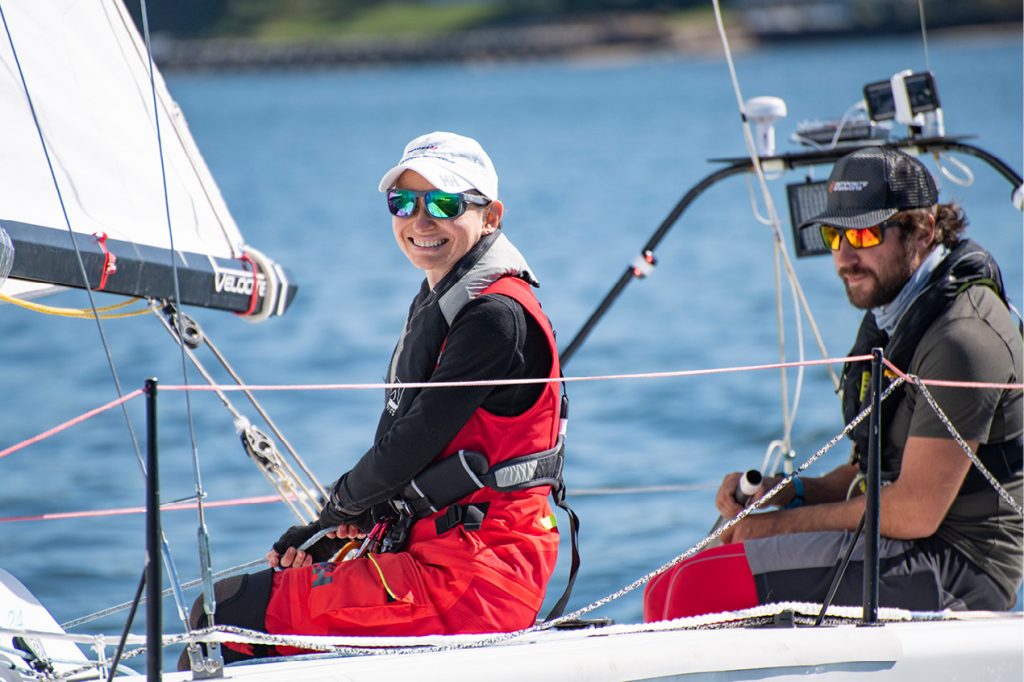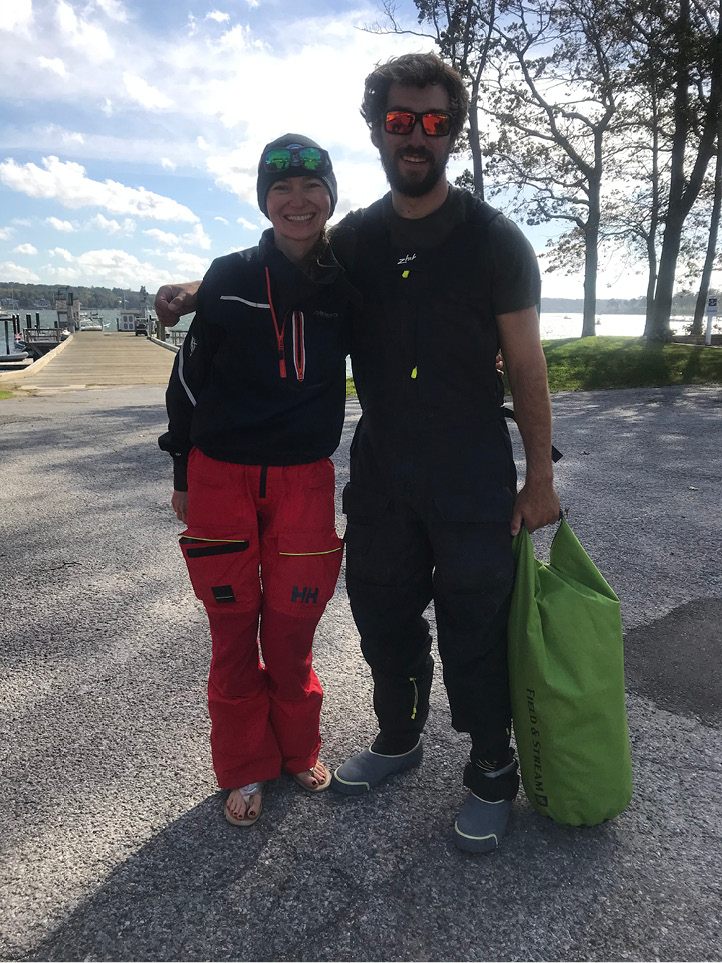By Barbara “Basia” A. Karpinska

Oakcliff’s six Melges 24s are optimized for doublehanded offshore sailing with jacklines, smaller spinnakers, reefable mains, movable water ballast in the form of water-filled fenders, running lights, and electronic navigational instruments. © Francis George /oakcliffsailing.org
When the idea of a modern Olympics emerged towards the end of the 19th century, the organizers were looking for a good popularizing event to connect the spectators to the glory of ancient Greece. In honor of the run from Marathon to Athens, a “marathon race” was envisioned to be featured in the first modern Olympic Games in 1896, an ultimate test of strength and endurance. The marathon quickly became an integral part of the Olympics, with major cities staging their own annual events.
Sailing has been an Olympic sport since 1896. Changing to reflect innovation, technology and evolving social norms, our sport has been present in every edition of the Games. Although more popular among male athletes, even in 1900, several women participated at the Olympic sailing regattas. Sailing was also one of the first sports to introduce a compulsory mixed gender event.
While Olympic sports offer a variety of formats, all events were historically held during “day time.” The absence of monitoring tools that would assure fair play over a longer period of time, and out of the jury’s direct line of sight, was an insurmountable barrier. With continued development of technology, GPS tracking and drones, supervision of a multi-day event has become logistically possible, and the Offshore Mixed Doublehanded race is becoming an equivalent of a marathon, far exceeding its complexity. Thanks to onboard cameras and live tracking, spectators can interact with the sport in ways previously unthinkable.
The Offshore Mixed Doublehanded race will be the longest and most challenging of all Olympic events in Paris 2024, and is anticipated to appeal to the general public and media. Blue water sailing has a long standing tradition and an engaged audience in France. Thanks to technology enabling live broadcasting during the race, the event has potential to become a reality show providing viewers with real time entertainment, and an educational access to the competitors while racing.
Importantly, the Mixed Offshore event is a format that focuses attention on gender equality and opportunity. With only two onboard, winning requires strong, interchangeable equals or tactically complementary, balanced teams. The format demands all-around sailing skills which is not as common outside of France as might be thought.
Having represented the USA in testing the new Olympic discipline in the Mixed Offshore Championship organized by the EUROSAF from Venice to Trieste in 2019, I was thrilled to be invited to compete in the Oakcliff Doublehanded Offshore Race, hosted by Oakcliff Sailing in Oyster Bay, NY last October.
While most other events in 2020 were canceled or postponed, under the leadership of Executive Director Dawn Riley the Oakcliff campus transformed into a “bubble” as an immediate response to the pandemic. Strict contact and cleaning protocols were implemented to allow for safe training and regatta participation. The Oakcliff Doublehanded Offshore Race, held in a spirit of the new shorthanded format, was well aligned with social isolation precautions dictated by the pandemic. All participants were required to demonstrate proof of a negative COVID-19 test result immediately prior to the regatta, and to follow safety and isolation protocols.

Co-skippers Basia Karpinska and Ethan Johnson celebrate their victory in the 2020 Oakcliff Doublehanded Offshore Race. © Francis George/oakcliffsailing.org
While my co-skipper Ethan Johnson [Oakcliff Training Program Director] and I are no strangers to the Melges 24, the challenge was sailing together as a team for the first time. Given Ethan’s and my work obligations outside of racing, and the weather conditions in the days leading up to the race, we worked together to prepare the boat but did not get a chance to practice on the water. With the rule of seven “P”s still in effect (Prior Proper Preparation Prevents Piss Poor Performance), we discovered that four “C”s (Communication, Collaboration, Chemistry and Compassion) are key components of a winning doublehanded team.
As part of pre-race preparations, Ed Cesare, Commodore of the Storm Trysail Club, graciously agreed to provide his navigational expertise. We held weather briefings, reviewing the course and routing plan daily starting with the 96-hour Surface Forecast from the NOAA Ocean Prediction Center (ocean.weather.gov), perhaps the single best site for marine weather information.
Our last routing the morning of the race with a 1305 start time projected a distance of 121 miles and a finish at 1130 the next day. We expected a run out to Faulkner Island, and a beat for a good portion on the way back; essentially a leeward/windward course. The race started relatively light, with a better wind field by the afternoon and solid double digits by the evening. Wind speeds picked up in the last third of the race as the next cold front approached from the west.
The duration of the race entailed a sprint rather than a marathon mindset. Longer races like the EUROSAF’s 2019 Mixed Offshore Championship, which lasted close to 48 hours, demand a greater amount of sleep, effectively forcing one of the crew to race solo while the co-skipper is resting. In preparation for the Oakcliff Race we openly discussed our vulnerabilities and sleep needs, and went into the race confident that our schedules would complement each other in a manner that would minimize single-handing. This was an important consideration for racing a Melges 24.
While Oakcliff’s Melges 24 fleet was modified for offshore sailing, the boat requires continuous manual interventions, both trimming and helming. When not using an autopilot, helming with a wheel allows for more functional flexibility, providing a luxury of sorts. Helming with a tiller on a Melges 24 is considerably more limiting. (I remember steering an L-30 with my hip and upper thigh on the wheel while simultaneously easing a halyard and gathering the aft part of a Code 0 while my co-skipper handled the bow and guided the front of the sail to the deck – a necessary intervention after a furling system failure in the dark and 20+ knots of breeze during the EUROSAF 2019 event).
While on the Oakcliff Doublehanded Offshore racecourse, we talked through reasons to jibe/tack vs. not considering the breeze we were in and anticipating what might come. We discussed our position and choices relative to our competition, and followed the navigation plan and Ethan’s tactical sixth sense. Keeping in mind pre-race advice from Rich du Moulin, President of the Storm Trysail Foundation, to reef sooner than we think, I was more agreeable than I would have been otherwise when Ethan suggested that we reef after rounding Faulkner’s Island. Very quickly it became apparent that the decision was right. We enjoyed a speedy, fun ride, planing down Long Island Sound all evening and into the night. When the time came to “go uphill” on the way home, an anticipatory reef allowed for a smooth gear change.
Following the safety protocol that required life vests to be worn on deck at all times, we stepped into the hatch to get dressed for the night as the activity necessitated a life vest removal. When it came time to rest however, we both remained on deck. The Melges 24 offers very limited space “down below,” and staying up top helped to continue contributing to an optimal weight management while resting. The boat functioned flawlessly and we did not experience any emergencies, yet both crew on deck provided extra “insurance” in case a quick intervention of two was needed.
Because hydration and nutrition grow in importance as the distance increases, we provisioned thoughtfully a mix of freeze-dried and real food. Eating was carefully choreographed into driving and trimming; pork chops with arugula and carrots with hummus were great morale boosters.
Although the forecast suggested a lighter breeze after midnight/during early morning, the velocity held relatively steady all around the course with a significant build up to mid- and high 20s closer to the finish. After the race was extended to include a trip down to Mamaroneck and a third rounding of the Cows, the last leg ended up being a beat with gusts around 30 knots.
Doublehanded offshore sailing is currently the fastest growing segment of our sport, and a true test of seamanship and racing skills. Associated technology encourages the spectators to get into sailing, and enables them to get better faster. This new format has recently been included in several regattas like American Yacht Club’s Spring Regatta and several Oakcliff events (oakcliffsailing.org/regattas/).
For a complete listing of global opportunities and more information, please visit Offshore Doubles (offshoredoubles.org), a new home for those interested in doublehanded offshore sailing, and those seeking to participate in sailboat racing with an increased understanding and appreciation. ■
Growing up in Cracow, Poland, Barbara “Basia” Karpinska started sailing little boats on little lakes as a Girl Scout. She’s sailed on the tall ships Dar Młodzieży and Fryderyk Chopin, delivered a Carkeek 60 from Hobart to Sydney, and completed numerous offshore/ocean races including podiums in the Vineyard, Newport Bermuda, Block Island, Around Long Island Regatta, Caribbean 600, Chicago Mac, Marblehead to Halifax, Transatlantic, and Rolex Fastnet.
Basia previously and currently races in the IC37, Etchells, M24, Sonar, J/105, J/44 and Swan 42 one-design classes, and enjoyed frostbiting her Cook 11 Snow White at American Yacht Club. She relishes team racing for the New York Yacht Club, where she serves on the Race, Events, Seamanship, Naval Services, and Communications Committees. She’s also a member of the Storm Trysail Club and the Buzzards Society.
When not on the water, Basia leads multispecialty surgical services as the Vice Chair for Administration at Rutgers New Jersey Medical School. She is a fellow and a member of the ACHE and the IWF, a mentor to youth, a board advisor, and a motivational speaker. Occasionally, she likes to sleep.
